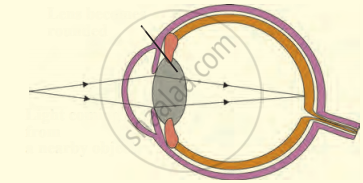Advertisements
Advertisements
प्रश्न
The following figure show the change in the shape of the lens while seeing distant and nearby objects. Complete the figures by correctly labelling the diagram.

उत्तर
Light coming from a nearby object-

APPEARS IN
संबंधित प्रश्न
List the parts of the human eye that control the amount of light entering into it. Explain how they perform this function.
Which. of the following has normal vision?
(a) Xc Xc
(b) Xc Y
(c) XC Xc
(d) Xc Yc
Explain why the image distance in the eye does not change when we change the distance of an object from the eye?
Describe the anatomy of the human eye.
Explain the mechanism of vision.
The optical prescription for a pair of spectacles is :
Right eye : −3.50 D
Left eye : −4.00 D
Are these lenses thinner at the middle or at the edges?
What is the name of:
the curved, transparent front surface of the eye?
What is the function of the lens in the human eye?
What job does the pupil of the eye do?
Give the scientific names of the following parts of the eye:
a clear window at the front of the eye.
Fill in the following blank with suitable words:
When light is dim, the pupil becomes................
The eyes of a person are focused (i) on a nearby object, and (ii) on a distant object, turn by turn. In which case:
the focal length of eye-lens will be the maximum?
How is the amount of light entering the eye controlled?
The term " accommodation" as applied to the eye, refers to its ability to:
(a) control the light intensity falling on the retina
(b) erect the inverted image formed on the retina
(c) vary the focal length of the lens
(d) vary the distance between the lens and retina
Mention if the following statement is true (T) or false (F) Give reason.
Short-sightedness and hyperopia are one and the same thing
Mention if the following statement is true (T) or false (F) Give reason.
Blind spot is called so because no image is formed on it.
With reference to the functioning of the eye, answer the question that follow:
What is the shape of the lens during distant vision?
Give scientific reason:
One can sense colours only in bright light.
What is the function of iris and the muscles connected to the lens in human eye?
Name the following:
White part of the eye.
Name the respective organs in which the following are located and mention the main function of each:
(i) Iris
(ii) Semicircular canals
Answer the following question.
Write the structure of eye lens and state the role of ciliary muscles in the human eye.
Differentiate between:
Yellow spot and Blind spot.
Name the following:
The pigmented circular area seen in the eye.
Name the following:
The innermost layer of the eye
Name the following:
Yellow spot and ciliary muscles are found in.
Name the following:
The part of the eye responsible for change in the size of the pupil.
State the Function:
Aqueous humour
State the Function:
Visual purple
Name the capacity of the eye lens to change its focal length as per need.
Write the name.
The fleshy screen behind cornea.
Write an Explanation.
Power of accommodation
The larynx has fold of tissue which vibrate with the passage of air to produce sound.
What is ‘white of the eye’?
Match the following:
| Column - I | Column - II |
| 1. Retina | a. Pathway of light |
| 2. Pupil | b. Far point comes closer |
| 3. Ciliary muscles | c. near point moves away |
| 4. Myopia | d. Screen of the eye |
| 5. Hypermetropia | f. Power of accommodation |
Match the following:
| Column - I | Column - II | ||
| 1 | Retina | a | Path way of light |
| 2 | Pupil | b | Far point comes closer |
| 3 | Ciliary muscles | c | near point moves away |
| 4 | Myopia | d | Screen of the eye |
| 5 | Hypermetropoia | e | Power of accomodation |
The thin, transparent extension of sclerotic layer found in front of the lens is ______.
